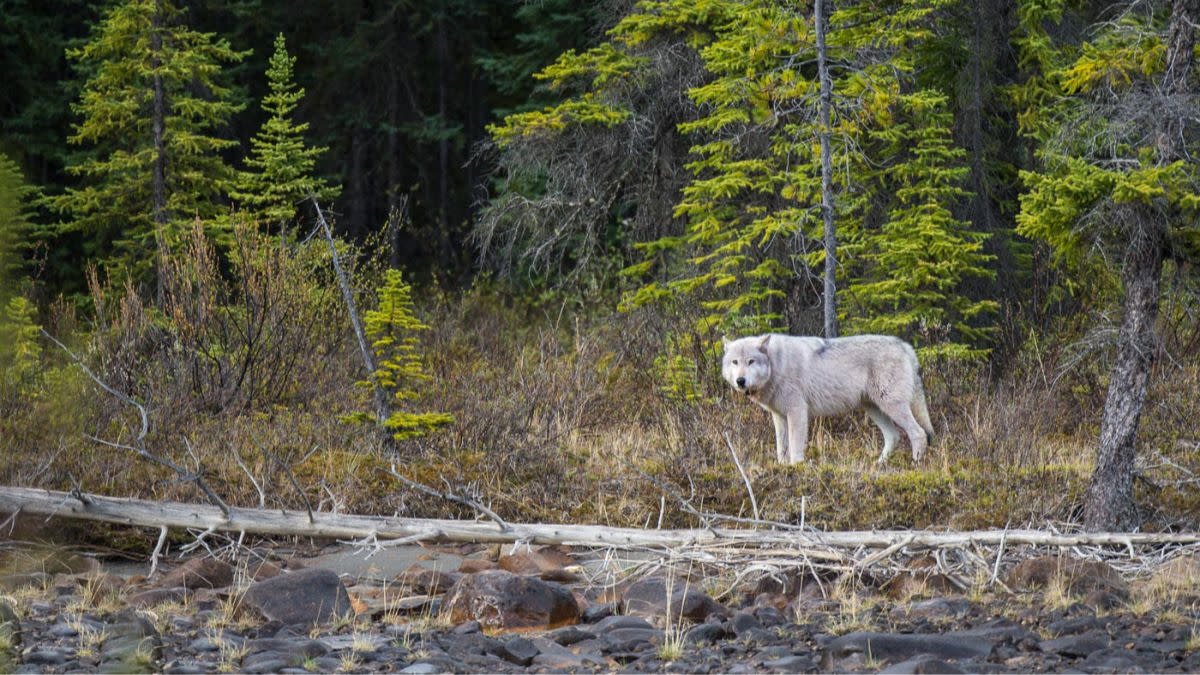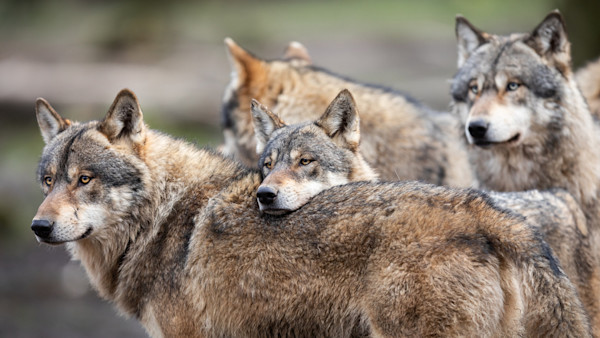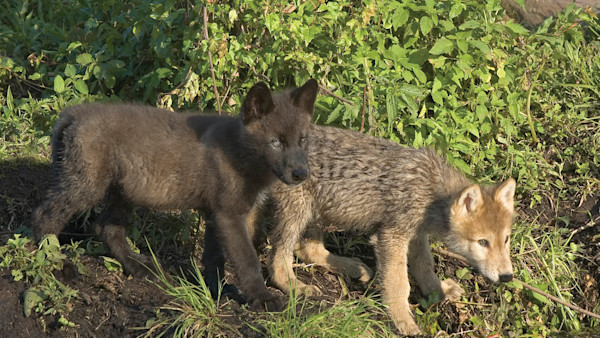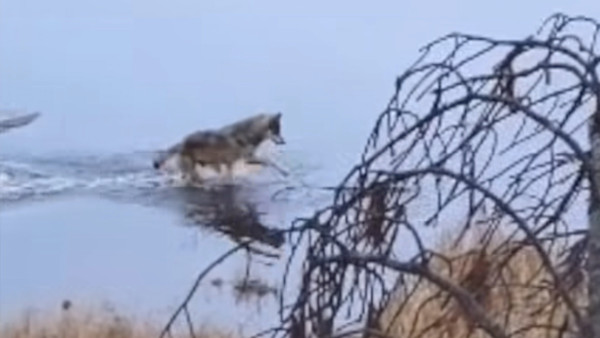
Riddle me this: How can a male wolf be both father and half-brother to a female wolf?
Answer: By breeding their shared mother.
Just such an Oedipal pairing about a decade ago begat what became the lone surviving “native-born” wolf duo on Isle Royale National Park in northwestern Lake Superior. The male and his daughter/half-sister became the last wolves standing on the 9-by-45-mile-long island in 2018, the inbred remnants of a population that established itself only 70 years before and peaked at 50 animals in 1980.
The genetically challenged pair had little or no ability to regenerate a healthy, self-sustaining wolf population on Isle Royale. Their inbred predecessors passed down crooked spines, extra vertebrae, extra ribs, “dead eyes” and other afflictions; and researchers observed the female rebuffing the male’s advances during her winter estrus in 2017, 2018, and 2019.
In 2018, the National Park Service launched a $2 million, five-year plan to re-establish a 20- to 30-wolf population, which presumably will segregate into two to four packs. Fifteen relocated wolves from around Gitche Gumee (Ojibwe for Lake Superior) roamed Isle Royale by the end of 2019. The plan calls to end restocking by 2021, and monitor the population for two years to see how it’s faring. The plan forbids further stocking.
Relative Newcomers
As discussed in an April 12, 2019, MeatEater article, wolves weren’t documented on the 206-square-mile island until 1948, apparently having crossed from the Ontario/Minnesota mainland earlier in the 1940s when winter ice “bridges” spanned that slice of Lake Superior. Once established on the island, wolves preyed on abundant moose, which first inhabited Isle Royale around 1910.
The wolf population remained healthy its first 40 years, likely because it maintained genetic diversity through new wolves crossing ice that formed most winters between Isle Royale and the mainland. With warmer winters prevailing the past 25 years, that 15-mile span froze less often and for less time, isolating the wolves from gene infusions.
Wolf restocking began in late September and early October 2018 with four Minnesota wolves. The work resumed in late February and March 2019 with eight wolves from Ontario’s Michipicoten Island Provincial Park (146 miles to the east in Lake Superior), and three from Ontario’s mainland. Three wolves from Michigan’s Upper Peninsula were released on Isle Royale in September 2019. All relocated wolves carry GPS collars that transmit their locations every five hours.
The Oedipus male died in an October 2019 attack, most likely by the new arrivals. A necropsy by the U.S. Geological Survey’s National Wildlife Health Center in Madison, Wisconsin, confirmed its cause of death. The male’s daughter/half-sister presumably remains alive, but it’s not tagged or collared so her fate isn’t verified.
From October 2018 through December 2019, the relocated wolves suffered four deaths and one defection: A female fled the island in late January 2019 when ice covered the expanse to the mainland. In addition, a male Minnesota wolf died of pneumonia; another Minnesota wolf was killed by rival wolves; a female Michigan wolf died from an infected leg-hold trap wound she suffered during capture; and a male Ontario wolf was too decomposed to identify a cause of death.
Even though 15 wolves were on Isle Royale by late winter 2019, none apparently arrived pregnant or mated after arriving. In the past, peak breeding on Isle Royale usually occurred during the third week of February, but researchers previously found evidence of mating from late January through early March. The only male wolf around all winter in 2018-19 was Oedipus, which stayed close to its daughter/half-sister.
Restoring Ecosystem Integrity
Mark Romanski, a Park Service biologist and Isle Royale’s natural resources division chief, said rebuilding the wolf population is an effort to restore “integrity and resiliency” to the island’s ecosystem. The NPS hopes the big carnivores will drive down Isle Royale’s booming moose population before the big herbivores eat away the island’s aspens, birch, balsam firs, and Canada yew. The 2019 moose population was estimated at 2,060, second only to a record 2,400 estimated in 1995.
Researchers from Michigan Technological University—a major collaborator in the restoration plan—documented “extremely high” levels of browse damage during winter 2018-19 to balsam fir saplings, the moose’s main cold-weather food source on Isle Royale. Data gathered by researchers Ky and Lisa Koitzch showed moose ate nearly 100% of new branches on fir saplings above the snowline.
Browsing moose are also blamed for much of the 75% decline in mature firs since 1846 on Isle Royale, and for reducing the forest’s fir component from 36% to 9% of all tree species. They’re also eliminating fir from the hardwood forests’ understory on the island’s western end.
Hungry moose are even stressing Isle Royale’s aquatic vegetation. MTU researchers documented moose virtually eliminating watershield, a floating-leafed plant that often covers the surfaces of boreal ponds and shallow lakes. Watershield was dominant on five ponds on Isle Royale’s eastern end in the late 2000s when moose numbers were low and covered up to 90% of the ponds’ surfaces. As moose boomed from 2012 through 2017 and congregated in ponds to eat during summer, watershield proved difficult to find by 2018.
Will the island’s “new and improved” wolf population reverse those trends? It’s too soon to say. As 2020 began, Isle Royale’s 15-wolf population included eight males and seven females. Analysis and results of onsite field work from January through March this year remain on hold and under review, given that Michigan’s COVID-19 lockdown began March 23, sending everyone home. NPS staff and biologists didn’t expect to return to Isle Royale until late May to prepare for the park’s scheduled June 15 reopening.
How About a Hunt?
Many hunters—and Michigan’s House of Representatives—think the NPS should conduct hunts to thin Isle Royale’s moose herd, but that would require federal approval. State Rep. Steven Johnson, R-Wyland, sponsored the moose hunt resolution, saying it had nothing to do with wolves. He said hunting would benefit the island’s ecosystem and provide “once-in-a-lifetime experiences” for hunters.
Johnson said he values Isle Royale, noting it’s the first place he ever went backpacking. “It’s something we want to protect,” he told The Daily Mining Gazette in Houghton, Michigan. He sponsored the resolution with Reps. John Chirkun, D-Roseville; Greg Markkanen, R-Hancock; David LaGrand, D-Grand Rapids; and Beau LaFave, R-Iron Mountain.
They sent the resolution to the NPS director in Washington, D.C., Michigan’s Congressional delegation; Gov. Gretchen Whitmer, and Daniel Eichinger, director of Michigan’s Department of Natural Resources. Michigan’s United Conservation Clubs also backed Johnson’s resolution. Amy Trotter, MUCC’s executive director, said hunting can manage moose numbers, and hunters are ready to participate.
The NPS, however, rejected moose hunting in 2018 while preparing the wolf restoration plan, saying hunts would require extra staffing, be logistically grueling, and deliver harvests too unpredictable for managing moose. NPS staff note the 15-mile boat crossing from Minnesota can be treacherous, and extracting moose would be difficult, given that carts and other wheeled devices are forbidden in federal wilderness areas.
Although some national parks and preserves allow hunting, it requires Congressional approval, which is typically granted in the property’s original charter. Hunting wasn’t specified when Congress designated Isle Royale a national park in 1931.
In contrast, 106 miles southwest of Isle Royale, the NPS’s Apostle Islands in Wisconsin included hunting when Congress designated those 21 islands and 12 miles of mainland as a national lakeshore in 1970. The Apostles have held deer hunts since 1985 and on four of its islands the past 10 years.
Deer densities are often low, the hunting difficult, and Lake Superior often intimidating. The results: Of 263 deer tags issued from 2010 to 2019, hunters registered 12 deer, a 4.6% success rate. When public hunting didn’t control the herd on Sand and York islands in the 2000s, the NPS in 2009 began using the USGS’s animal-control specialists to cull the herd. They’ve since removed 30 deer from York and 150 deer from Sand.
Monitoring Predator and Prey
As the hunting debate rolls on, reducing Isle Royale’s moose herd will depend on wolves and the moose themselves, as they literally eat away their food sources. Both will be watched and their efforts converted to data. MTU’s researchers have studied the island’s wolf/moose relationship since 1966, and they’re confident the wolves’ GPS collars, as well as GPS collars on 20 female moose, will document their numbers, impacts and behaviors better than ever.
Still, the tasks are large. Isle Royale’s 2019 moose population of 2,060 was a 300% increase from an estimated 515 in 2011, spurred by 20% annual growth rates. The wolf population, meanwhile, went the opposite direction, sliding to 16 in 2011, nine in 2012, and three in 2015 before leaving only Oedipus and his daughter/half-sister in 2016.
Historical data for both populations indicate Isle Royale needs about 20 to 30 wolves to keep moose numbers below 1,000. When the wolf population averaged 14 from 1987 through 1995 while battling back from canine parvovirus, the moose herd averaged an estimated 1,627, including the record 2,400 in 1995. In contrast, when wolf numbers averaged 23 from 1996 through 2009, moose numbers averaged 722, including a low of 385 in 2006.
Isle Royale’s new wolves looked well-fed in 2018-19, and individuals killed moose calves. Although pairs and a group of three wolves appeared to be running mates, Romanski said it was too soon to declare them a pack. That designation requires they breed and rear pups.
During summer 2019 field work, NPS staff and State University of New York researchers used GPS data from the wolves’ collars to inspect 381 wolf congregation locations and identify 60 kill sites. Most kills (54.5%) were moose, of which 63% were calves, but the trackers also identified beavers and snowshoe hares. Earlier field work in winter/spring 2019 by MTU researchers and “Moosewatch” volunteers located 24 moose carcasses, including one that died from falling, and another from malnutrition.
MTU’s 2018-2019 annual report calculated that year’s kill rate at nearly two moose per wolf per month, or 30% higher than the highest such rate the previous 38 years. They attribute the record rate to a high moose-to-wolf ratio, small group sizes among wolves, and the possibility that GPS collars helped researchers find kill sites more easily.
Even so, the researchers calculated that wolves killed only 2.2% of Isle Royale’s moose herd in 2018-19, well below the long-term average of 9.9% from 1971 to 2011 before the wolf population’s collapse. The MTU report noted: “We expect (this rate) to remain relatively low, until wolf abundance increases considerably or moose abundance decreases due to limited browse.”
Conclusion
Isle Royale’s researchers also hope to discover other insights into wolf and moose, such as: How will individual wolves adapt to Isle Royale? Will they form packs? Do wolves swim for the hell of it? Why have moose skull sizes been shrinking in recent years?
“It’s still too early and the data samples are too small to speculate or draw conclusions about any of that,” Romanski said. “Plus, even though we see their locations every five hours, we don’t know where they go in between. They can cover lots of ground in five hours.”
The closer biologists look at this petri dish island, the more questions they have. All we really seem to know right now is that the Isle Royale story is far from finished.
Feature image via Tony Bynum.







Conversation